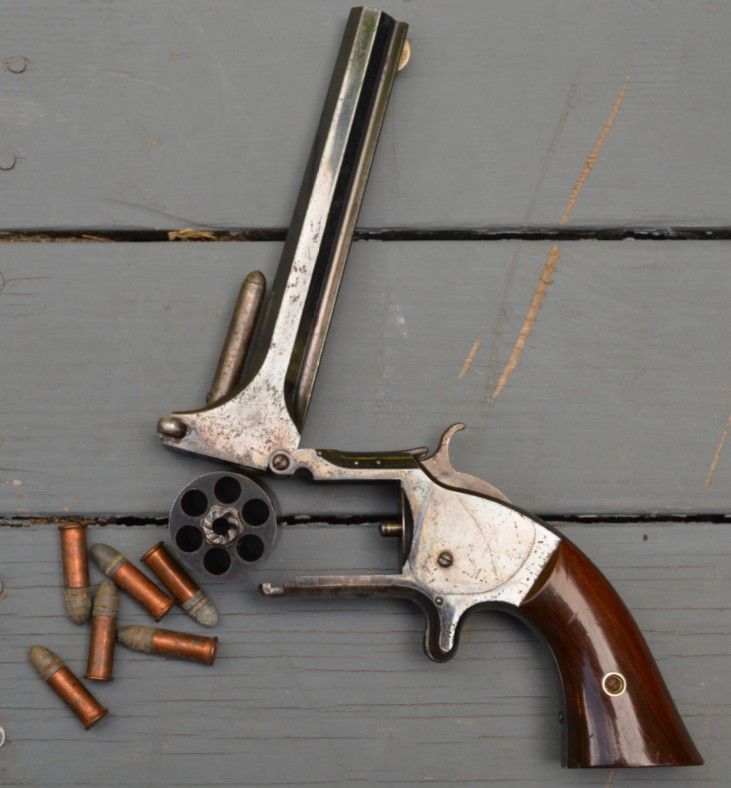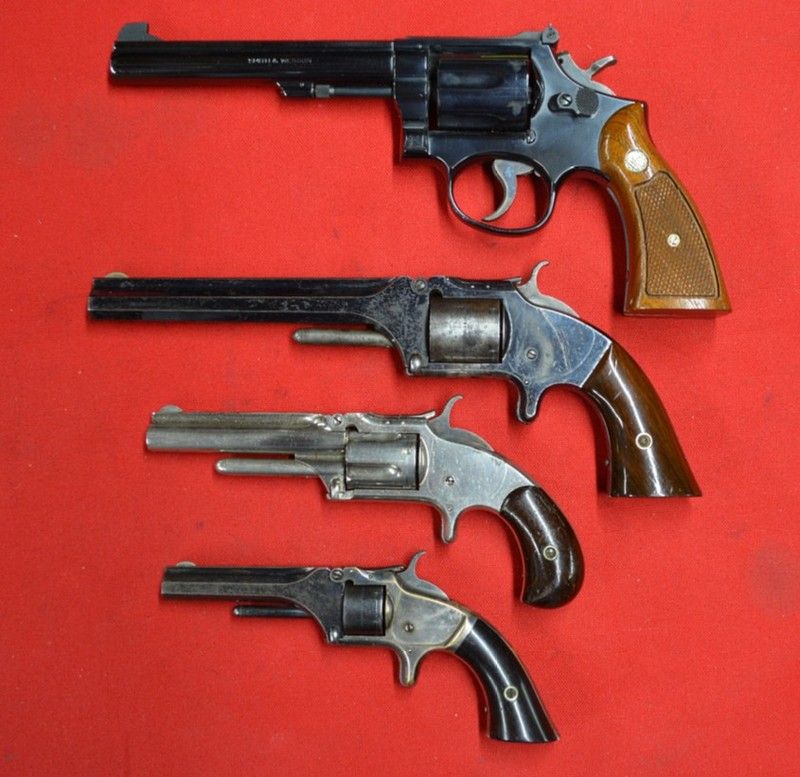Driftwood Johnson
New member
Howdy
In 1857, when Smith and Wesson first started making revolvers, the guns they made at that time were known as Tip Ups. At least that's the name we know them by today. Unlike the Top Breaks, which came later, and opened by rotating the barrel down, a Tip Up was loaded by releasing a catch at the bottom of the barrel, and then rotating the barrel up. Then the cylinder was pulled forward out of the frame. The cylinder was loaded and it was reinstalled on the frame, then the barrel was rotated down to close the latch and the gun was ready to fire.
This is a Number 2, Old Army. This model was produced from 1861 until 1874. This particular one left the factory in 1870. It is chambered for the 32 Rimfire Long cartridge and the cylinder held six shots.

Here is a photo of the gun broken open for loading. The rod under the barrel was used to poke the spent cartridges out of the cylinder for reloading.

A few weeks ago I came across another one. It was in very nice shape, although it has clearly been refinished. But something about it was a little bit unusual. The 'ejector rod' under the barrel had been partially turned down to a smaller diameter.

When I opened it up I saw that it had been modified to shoot 22 Rimfire ammunition. The chambers and the barrel had been sleeved. A little bit of steel had been welded onto the face of the hammer and shaped so it would fire the smaller 22 RF cartridges. The rifled bore was bright and shiny, like new, as were the sleeved chambers.

I have never wanted to shoot any of my other Tip Ups, even though I have a couple of boxes of the correct ammunition. The guns are too old and I did not want to chance it. But clearly this gun, with it's modern steel sleeves and chambers would be a different story, so it went home with me. The gun functions perfectly, and it locks up almost as tight as when it left the factory. No, I don't know yet exactly when it left the factory, but I suspect from the Serial Number it is a very early one. At some point in time, probably fairly recently, an unknown gunsmith did the conversion.
I did not want to shoot modern 22 Long Rifle ammo out of it, even though the barrel and chambers could probably take it, I did not want to subject the latch and hinge to the force of modern Long Rifle ammo. But then I lucked into a few boxes of CCI 22 CB Longs. Kind of like the old CB Caps, loaded very, very mild.
So I took it to the range and fired a few cylinders full out of it. What fun. The CB Longs recoil about like a BB gun. With its bright shiny new barrel sleeve the gun is very accurate. I didn't want to overdo it so I only fired a few cylinders full.

Here is a photo of the three different sizes of Tip Ups that S&W made, compared to a modern K frame 38. Top to bottom in the photo are a Model 14, No. 2 Old Army, No. 1 1/2 New Model, and a No. 1 Second Issue. The upper two are both 32 RF, the bottom one is chambered for what we eventually came to call the 22 Short.

S&W controlled the Rollin White patent when they were making the Tip Ups, which prevented any other American manufacturer from making cartridge revolvers. When the patent expired in 1869, other manufactures could start making cartridge revolvers too. The No. 2 was popular with Union officers during the Civil War. Not as powerful as the Cap & Ball revolvers built by Colt and Remington, but it could be reloaded much quicker.
S&W never made a Tip Up larger than 32 caliber, although they experimented with a 44 caliber prototype. They concluded the action and lock up of the Tip Ups was not strong enough for anything larger than 32 Rimfire. In 1869, when the White patent expired, S&W introduced their first Top Break, a much stronger design. The first Top Break they built was the 44 caliber American Model.
In 1857, when Smith and Wesson first started making revolvers, the guns they made at that time were known as Tip Ups. At least that's the name we know them by today. Unlike the Top Breaks, which came later, and opened by rotating the barrel down, a Tip Up was loaded by releasing a catch at the bottom of the barrel, and then rotating the barrel up. Then the cylinder was pulled forward out of the frame. The cylinder was loaded and it was reinstalled on the frame, then the barrel was rotated down to close the latch and the gun was ready to fire.
This is a Number 2, Old Army. This model was produced from 1861 until 1874. This particular one left the factory in 1870. It is chambered for the 32 Rimfire Long cartridge and the cylinder held six shots.

Here is a photo of the gun broken open for loading. The rod under the barrel was used to poke the spent cartridges out of the cylinder for reloading.

A few weeks ago I came across another one. It was in very nice shape, although it has clearly been refinished. But something about it was a little bit unusual. The 'ejector rod' under the barrel had been partially turned down to a smaller diameter.

When I opened it up I saw that it had been modified to shoot 22 Rimfire ammunition. The chambers and the barrel had been sleeved. A little bit of steel had been welded onto the face of the hammer and shaped so it would fire the smaller 22 RF cartridges. The rifled bore was bright and shiny, like new, as were the sleeved chambers.

I have never wanted to shoot any of my other Tip Ups, even though I have a couple of boxes of the correct ammunition. The guns are too old and I did not want to chance it. But clearly this gun, with it's modern steel sleeves and chambers would be a different story, so it went home with me. The gun functions perfectly, and it locks up almost as tight as when it left the factory. No, I don't know yet exactly when it left the factory, but I suspect from the Serial Number it is a very early one. At some point in time, probably fairly recently, an unknown gunsmith did the conversion.
I did not want to shoot modern 22 Long Rifle ammo out of it, even though the barrel and chambers could probably take it, I did not want to subject the latch and hinge to the force of modern Long Rifle ammo. But then I lucked into a few boxes of CCI 22 CB Longs. Kind of like the old CB Caps, loaded very, very mild.
So I took it to the range and fired a few cylinders full out of it. What fun. The CB Longs recoil about like a BB gun. With its bright shiny new barrel sleeve the gun is very accurate. I didn't want to overdo it so I only fired a few cylinders full.

Here is a photo of the three different sizes of Tip Ups that S&W made, compared to a modern K frame 38. Top to bottom in the photo are a Model 14, No. 2 Old Army, No. 1 1/2 New Model, and a No. 1 Second Issue. The upper two are both 32 RF, the bottom one is chambered for what we eventually came to call the 22 Short.

S&W controlled the Rollin White patent when they were making the Tip Ups, which prevented any other American manufacturer from making cartridge revolvers. When the patent expired in 1869, other manufactures could start making cartridge revolvers too. The No. 2 was popular with Union officers during the Civil War. Not as powerful as the Cap & Ball revolvers built by Colt and Remington, but it could be reloaded much quicker.
S&W never made a Tip Up larger than 32 caliber, although they experimented with a 44 caliber prototype. They concluded the action and lock up of the Tip Ups was not strong enough for anything larger than 32 Rimfire. In 1869, when the White patent expired, S&W introduced their first Top Break, a much stronger design. The first Top Break they built was the 44 caliber American Model.
